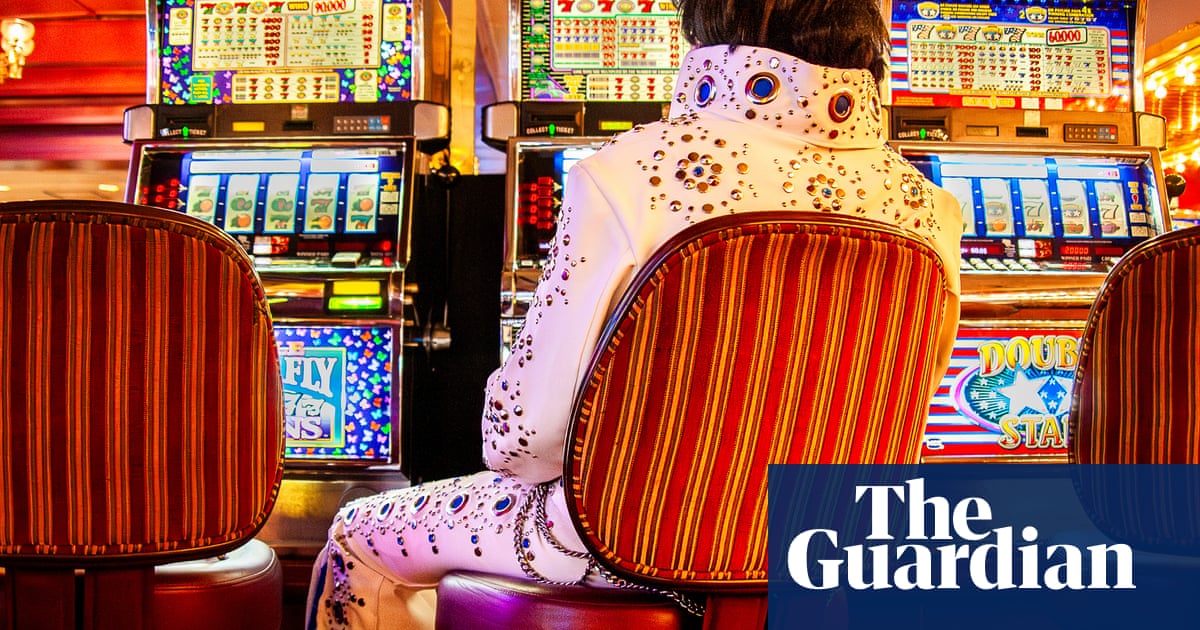As a kid, I would see a new casino every time I visited Vegas with my family. They were huge, multimillion dollar investments and even then, I knew that money had come from people losing it in machines. That’s probably why I don’t gamble. My dad only actually took us into a casino a couple of times, but I remember him believing he would win and my mother being more rational about it.
Thinking about it now, it’s absurd to take your kids to Vegas. My friend Rich remembers his parents checking him and his brother in at theCircus Circus hoteland casino – I think there was maybe a trampoline for children to jump on while the parents gambled. Afterwards, they’d hand in their ticket and pick the kids up again, like you do with your coat at the theatre.
In my 20s, I’d go to Vegas with friends and, while they were gambling, I’d be documenting, running around and taking photos wherever I could. I began to realise that the gap between the absurd commercials we have in the US for casinos that promise the world, and the reality that I was seeing, was huge, almost to a comical degree. The photographs I’d been accumulating started to form a cohesive body of work, showing the contrast between the glamour in the marketing, and the actuality – which is more like going to the airport than a big night out in Monte Carlo.
I took trips to places well known for their casinos, such as Reno, Nevada and Atlantic City, and whenever I was somewhere in the US that had one, I would seek it out. I tend to use a hit and run approach when photographing inside them. If I see security looking at me, or if other people are becoming aware of me, I’ll just move on – there’s always an embarrassment of riches to photograph, you could just go to the next table, or even the next casino. I also don’t want to be perceived as someone who might be helping someone cheat, so I try to avoid any card games.
I feel like I’m setting the stage for a story, and then you let your mind fill in the blanks. This photograph of an Elvis impersonator is an example of that – one image that says 1,000 words. It’s pretty much the iconic image of myCasinoland book. Elvis was the king but there was a darker side to him too, which reflects the difference between the marketing of casinos and their reality.
The photograph was taken in 2012 and it epitomises Vegas – not just because of Elvis, but also the lights and the colour. For some reason I feel more emotion when there’s more saturation in an image. There’s so much distraction going on here, but it all frames the king in the centre. He’s kind of slumped back at the slot machine: you see him from the back but you know exactly who he is.
Often players go into a particular mental state at the slot machines, where they seem to be aware of nothing else. They get locked into a zone where it’s just them and the machine. I could often get pretty close, and was able to capture what was happening without them seeing me. You have to be careful though – people have come at me a couple of times. On one occasion, when I was still shooting on film, the sound of my Olympus woke a guy I’d just photographed slumped across a machine, and he really wanted to fight me. There was no reasoning with him. I managed to dodge into a club and amazingly the velvet rope kept him at bay – he wouldn’t cross it.
Nowadays I carry a small Fuji, but phone cameras have got good enough for me to use for stealth work. If I pick up my Nikon with its longer lens, it’s like I’m about to point a gun at someone. In the age of social media, people are much more suspicious of a photographer’s motives than they used to be, but I am a positive person and want the best for everybody. Someone described my work as documenting the fall of an empire in the deserts of Nevada, but I’m doing it with a sense of humour and a light touch.
Born:Ohio, 1969Trained:“Studied art history at the University of San Diego, spent many hours at the Museum of Photographic Arts bookstore in Balboa Park, and regularly snuck into film classes. I fell in love with photography while studying in Florence, Italy, in my second year of college and have been pretty much self-taught since then by looking at paintings in museums and watching great films.Influences:“Henri Cartier-Bresson, Brassaï, Helen Levitt, Bill Owens, Henri de Toulouse-Lautrec, Hunter S Thompson.”High point:“As a Pollyanna optimist, I have to believe my high point has yet to happen – but havingEdward Snowden share an image I created with The Yes Menstands out.”Low point:“To survive as an artist you have to accept a barrage of rejection and move on.”Top tip:“Chuck Closenoted that photography is one of the easiest art forms to learn but the hardest to find your voice. I recommend learning as much craft as you can, but at some point you have to look deep inside yourself to carve your path.”
Michael Rababywill be signing copies of Casinoland – Tired of Winning on 11 July atArles photography festival
